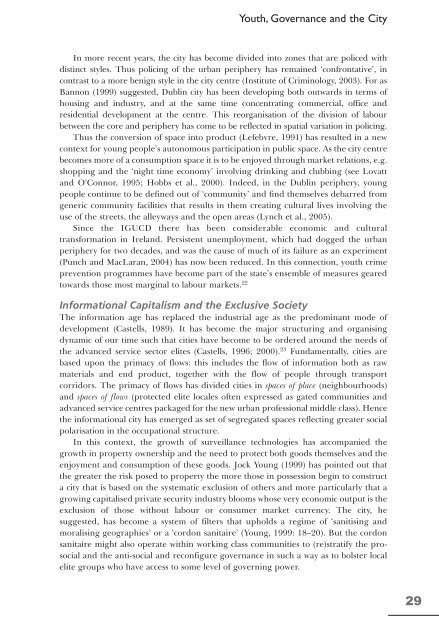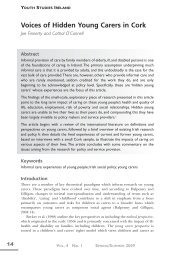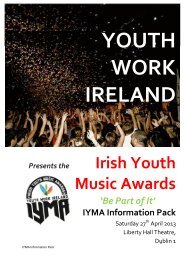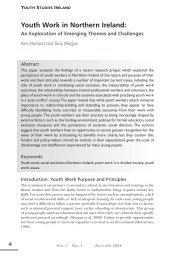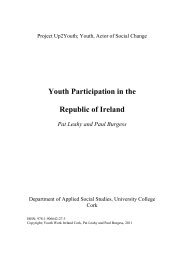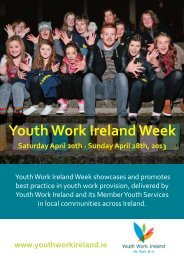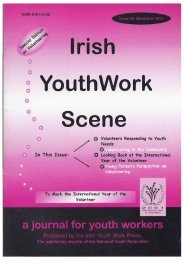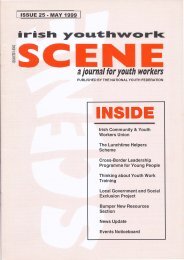Download full edition - Youth Work Ireland
Download full edition - Youth Work Ireland
Download full edition - Youth Work Ireland
You also want an ePaper? Increase the reach of your titles
YUMPU automatically turns print PDFs into web optimized ePapers that Google loves.
<strong>Youth</strong>, Governance and the CityIn more recent years, the city has become divided into zones that are policed withdistinct styles. Thus policing of the urban periphery has remained ‘confrontative’, incontrast to a more benign style in the city centre (Institute of Criminology, 2003). For asBannon (1999) suggested, Dublin city has been developing both outwards in terms ofhousing and industry, and at the same time concentrating commercial, office andresidential development at the centre. This reorganisation of the division of labourbetween the core and periphery has come to be reflected in spatial variation in policing.Thus the conversion of space into product (Lefebvre, 1991) has resulted in a newcontext for young people’s autonomous participation in public space. As the city centrebecomes more of a consumption space it is to be enjoyed through market relations, e.g.shopping and the ‘night time economy’ involving drinking and clubbing (see Lovattand O’Connor, 1995; Hobbs et al., 2000). Indeed, in the Dublin periphery, youngpeople continue to be defined out of ‘community’ and find themselves debarred fromgeneric community facilities that results in them creating cultural lives involving theuse of the streets, the alleyways and the open areas (Lynch et al., 2005).Since the IGUCD there has been considerable economic and culturaltransformation in <strong>Ireland</strong>. Persistent unemployment, which had dogged the urbanperiphery for two decades, and was the cause of much of its failure as an experiment(Punch and MacLaran, 2004) has now been reduced. In this connection, youth crimeprevention programmes have become part of the state’s ensemble of measures gearedtowards those most marginal to labour markets. 22Informational Capitalism and the Exclusive SocietyThe information age has replaced the industrial age as the predominant mode ofdevelopment (Castells, 1989). It has become the major structuring and organisingdynamic of our time such that cities have become to be ordered around the needs ofthe advanced service sector elites (Castells, 1996; 2000). 23 Fundamentally, cities arebased upon the primacy of flows: this includes the flow of information both as rawmaterials and end product, together with the flow of people through transportcorridors. The primacy of flows has divided cities in spaces of place (neighbourhoods)and spaces of flows (protected elite locales often expressed as gated communities andadvanced service centres packaged for the new urban professional middle class). Hencethe informational city has emerged as set of segregated spaces reflecting greater socialpolarisation in the occupational structure.In this context, the growth of surveillance technologies has accompanied thegrowth in property ownership and the need to protect both goods themselves and theenjoyment and consumption of these goods. Jock Young (1999) has pointed out thatthe greater the risk posed to property the more those in possession begin to constructa city that is based on the systematic exclusion of others and more particularly that agrowing capitalised private security industry blooms whose very economic output is theexclusion of those without labour or consumer market currency. The city, hesuggested, has become a system of filters that upholds a regime of ‘sanitising andmoralising geographies’ or a ‘cordon sanitaire’ (Young, 1999: 18–20). But the cordonsanitaire might also operate within working class communities to (re)stratify the prosocialand the anti-social and reconfigure governance in such a way as to bolster localelite groups who have access to some level of governing power.29


